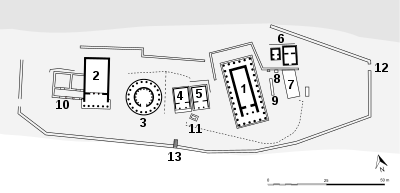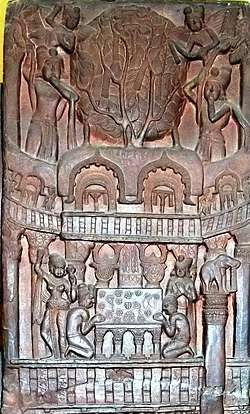Tholos (architecture)


A tholos (pl. tholoi), from Ancient Greek θόλος), in Latin tholus (pl. tholi), is an architectural feature that was widely used in the classical world. It is a round structure, usually built upon a couple of steps (a podium), with a ring of columns supporting a domed roof. It differs from a monopteros (Ancient Greek:ὁ μονόπτερος from the Polytonic: μόνος, only, single, alone, and τὸ πτερόν, wing) a circular colonnade supporting a roof but without any walls, which therefore does not have a cella.[1]
Classical world
Greece
In Greece, the Tholos is a round temple of Greek 'peripteral' design completely encircled by a colonnade. A famous Tholos can be seen in Delphi, the Tholos of Delphi. It has been dated to 370-360 BCE. Its role remains unclear.
The Philippeion in the Altis of Olympia was an Ionic circular memorial in limestone and marble, a tholos, which contained chryselephantine (ivory and gold) statues of Philip's family; himself, Alexander the Great, Olympias, Amyntas III and Eurydice I.
- The Tholos of Delphi. 370-360 BCE.
 Delphi Temple of Athena Pronaia with Tholos.
Delphi Temple of Athena Pronaia with Tholos. Section of the Tholos of Epidauros.
Section of the Tholos of Epidauros. Remains of the Tholos of Athens.
Remains of the Tholos of Athens.- The Philippeion, in Olympia.
Italy
In Roman cities they could often be found in the center of the macellum (market),[2][3] where they might have been where fish were sold. Other uses for the central tholos have been suggested, such as the place where official weights and measures were held for reference or as shrines to the gods of the market place. Some macella had a water fountain or water feature in the centre of their courtyard instead of a tholos structure.
India


Some of the earliest free-standing temples in India are thought to have been of a circular type, as the Bairat Temple in Bairat, Rajasthan, formed of a central stupa surrounded by a circular colonnade and an enclosing wall, built during the time of Emperor Ashoka and near which were found several Minor Rock Edicts.[4] Ashoka also built the Mahabodhi Temple in Bodh Gaya circa 250 BCE, also a circular structure, in order to protect the Bodhi tree. Representations of this early temple structure are found on a 100 BCE relief from the stupa railing at Bhārhut, as well as in Sanchi.[5] These circular-type temples were also found in later rock-hewn caves such as Tulja Caves or Guntupalli.[4]
It has been suggested that these circular structures with colonnades may have originated with the Greek circular Tholos temple, as in the Tholos of Delphi, but circular wooden huts in India are a more likely source of inspiration.[6]
Neo-Classical
The upper part of the US Capitol is a Tholos. It houses the lighting at the very top of the Dome and serves as a base for the Statue of Freedom. The Panthéon in Paris is also topped by a tholos.[7]
.jpg) US Capitol tholos.
US Capitol tholos.- US Capitol tholos.
 Panthéon in Paris.
Panthéon in Paris. Panthéon in Paris.
Panthéon in Paris.
Others
References
- ↑ Curl, James Stevens (2006). Oxford Dictionary of Architecture and Landscape Architecture, 2nd ed., OUP, Oxford and New York, p. 500. ISBN 978-0-19-860678-9.
- ↑ Dyson, Stephen L. (1 August 2010). Rome: A Living Portrait of an Ancient City. JHU Press. p. 252. ISBN 9781421401010.
- ↑ Holleran, Claire (26 April 2012). Shopping in Ancient Rome: The Retail Trade in the Late Republic and the Principate. Oxford University Press. p. 161. ISBN 019969821X. Retrieved 1 April 2016.
- 1 2 Le, Huu Phuoc (2010). Buddhist Architecture. Grafikol. pp. 233–237. ISBN 9780984404308.
- ↑ "Sowing the Seeds of the Lotus: A Journey to the Great Pilgrimage Sites of Buddhism, Part I" by John C. Huntington. Orientations, November 1985 pg 61
- ↑ Le, Huu Phuoc (2010). Buddhist Architecture. Grafikol. p. 236. ISBN 9780984404308.
- ↑ Adomenas, Mantas (2002). Qu'est-ce que la philosophie présocratique ?: What is presocratic philosophy ? (in French). Presses Univ. Septentrion. p. 348. ISBN 9782859397401.
_-2.jpg)
_Petra_Jordan1461.jpg)